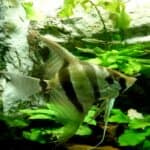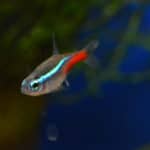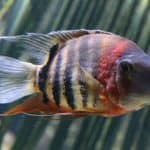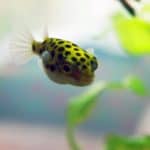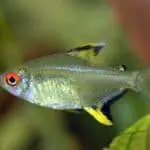The next time you browse the fish section at your local pet store, keep an eye out for some freshwater Angelfish.
Keeping an Angelfish in your aquarium is a great way to add some variety and spice up your collection. It is also known to be quite hardy, so you won’t have to worry about it too much.
This article will cover all aspects of this species and its maintenance in home aquariums.
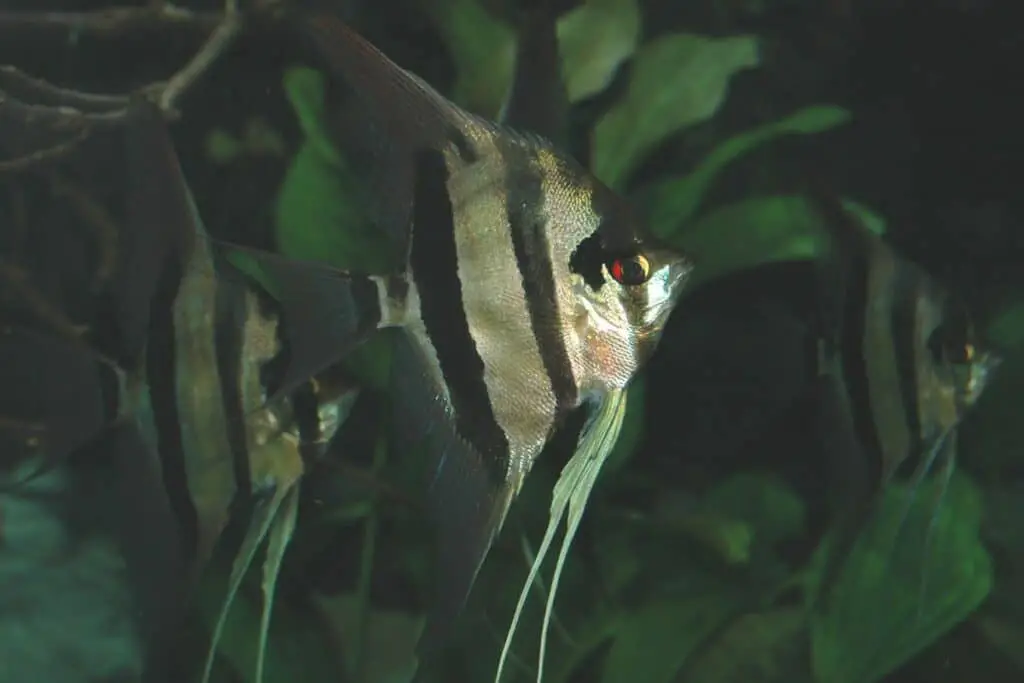
Species Summary
Angelfish are found in the Amazon Basin in South America. More specifically, along the Ucayali, Solimões, and Amazon rivers, Amapá (Brazil) river, Oiapoque River in French Guiana, and Essequibo Rivers in Guyana. There are introduced populations worldwide, in countries such as Fiji and the southern United States.
They reside in environments with medium to low water flow, such as large lakes, flooded forests, and rivers that are amid dense aquatic vegetation with many roots and trunks.
In addition, these fish are easily distinguishable by their flat bodies and varied colors. Some Angelfish have stripes running along their body, and all have long fins called veils.
Angelfish Care Guide
The Angelfish is a resistant and easy-to-care fish! With just a little bit of in-depth knowledge about the species, their habits, and behaviors, you can easily care for them.
Tank Size
The height of the tank is a crucial factor to consider when thinking about keeping Angelfish, as they are tall fish. The dimensions of the aquarium should start at 40″ x 15″ x 20″. This size accommodates a small group well, offering them plenty of room to swim around and be happy.
Tank Mates
Angelfish are relatively peaceful animals and can coexist without problems with other fish of similar size and behavior; they are able to coexist with countless other fish species in a large community aquarium.
Species such as Corydoras, Apistogramma, Neon and other Tetras, Tiger Barbs, and Bristlenose Plecos make great tank mates for Angelfish.
Same Species Tanks
It is typically kept as a single species either in large aquariums or biotope-type aquariums where the species’ natural habitat is replicated.
When kept on its own, the Angelfish presents an impressive beauty. However, these fish can have an intense dispute over the group’s hierarchy, so keeping several specimens in the same aquarium is recommended.
Once the group hierarchy is defined, they tend to be more peaceful with members of the same species. As they grow together, they will form couples, develop a strong family bond, and defend their territories at all costs.
Water Parameters
This species of fish is very resistant, supporting a range of parameters. They are only susceptible to pollutants and the accumulation of organic matter if the levels in their environment are high.
The perfect temperature for its maintenance is 77 to 86 F. The ideal pH range is between 6.8 to 7.2.
What to Put in Their Tank
It’s easy to keep your Angelfish healthy and happy — just ensure you have a well-sized aquarium heater and filtering system. Remember that the filtering system should not create a medium to moderate flow.
Moreover, decorating their habitat with driftwood and rocks is a good idea. This will give them places to hide and establish territories.
Common Diseases
These fish are pretty tough. They will not likely get sick if you keep their tank clean and stress-free.
But as it is not always easy to achieve a pristine aquarium, we often see in different tanks Angelfish with susceptibility to hole-in-the-head disease and stress-related illnesses, such as Ich and infection.
Food and Diet
The Angelfish is a voracious eater, chowing down on anything that fits in its mouth — animals included. In fact, the primary diet of this species is based on foods of animal origin, mainly fish and crustaceans in their natural environment.
This fish may have difficulty eating food in aquariums when of wild origin; the keeper must be patient and persistent during the food transition.
If you want your Angelfish to look their best, it’s a good idea to feed them high-quality commercial feed as well as live, fresh or frozen foods like bloodworms, brine shrimp and daphnia.
Lifespan
Under conditions where all aquarium parameters are kept stable and the ideal diet, this animal can live for more than six years. The most common lifespan is around five years.
These animals typically have shorter lifespans in the wild due to their increased susceptibility to disease, predation, and other environmental causes.
Appearance
The body is flat, with a relatively large dorsal and anal fin. Wild individuals present coloration composed of grayish tones with about four black stripes. Due to breeder crossings and selection, specimens with varied colors and fins patterns emerged.
The variety of the Angelfish is most often named after its pattern and architecture. For example, the Veil variety is characterized by a tail fin reaching more than twice the size of the fish’s body.
Angelfish with a caudal fin that is proportionate to their body size are classified as semi-veils. There is also a variety called pearls, in which the scales emit a pearly shine.
Size
The Angelfish is a fast-growing fish that can reach up to 6 inches when well cared for, but the average size is around 4.7 inches.
Behavior and Temperament
It is best to keep the Angelfish with similar habits in a community aquarium to prevent stress. If tank parameters are inadequate, this can lead to the fish not eating and hiding for days.
We recommend keeping this fish in groups of at least six individuals. If pairs or trios are kept, there may be severe persecution of the weakest fish in the group, even in a well-established aquarium.
Breeding
In nature, its reproductive period follows the rhythm of floods, with the change in water chemistry being one of the main factors triggering the reproductive process.
On the other hand, breeding Angelfish in captivity is a relatively simple process routinely carried out by commercial breeding operations and accidental breeding in home aquariums.
It reaches sexual maturity at around ten months. They are monogamous fish; after forming the couple, they will choose and clean the place for spawning, usually some flat surface object such as leaves, stones, rocks, or even glass. The female will then release sticky eggs, which the male will readily fertilize.
After the courtship ritual, the couple will constantly oxygenate the eggs and defend themselves from all intruders. One of the parents removes an egg to avoid exponential propagation to the other eggs whenever it appears sniffled.
The fry hatching occurs in 2 days, and the larvae remain in the yolk sac for another 4-5 days. The parents usually take care of the progeny for a few weeks.
Gender Differences: Male vs Female
There is no apparent sexual dimorphism in adult animals, except in the breeding season when females have a large, backwards-facing ovipositor and males have a thin, forward-facing sperm.
Angelfish Fun Facts
- Angelfish is one of the most popular freshwater fish globally, and records date its breeding in captivity in the 1930s. Man creates numerous color varieties through selective breed.
- Wild fish, just like the Altum Angels, are challenging to keep due to the water conditions they need and their difficulty feeding.
- Animals striped in black and silver are trendy. When the colors are mixed, the variety is called Marble, and when the tone is gray, the array is called Smoke. When dark (black) areas form circles, the type is called clown; the ideal specimen of this variety should be white or silver and have three well-defined and isolated black rings on each side of the fish’s body, with no pigmentation in other areas.
- In the leopard variety, the fish has several small circular spots all over the body, including the tail fin, giving an appearance similar to that of a leopard’s coat. Usually, in these animals, the body is grayish. The koi variety is identical to gold but has an intense yellow or reddish spot on the upper region of the head, which should be well-defined and restricted to the area mentioned.
- Monochromatic animals are lovely and desired. We can find entirely black animals, where even the whole eye is black, not having the reddish spot typical of the species. The golden variety also has a soft golden-yellow tone, but getting this variety with a veiled tail is not common.
References
Nomura, H., 1984. Nomes científicos dos peixes e seus correspondentes nomes vulgares. In H. Nomura (ed.). Dicionário dos peixes do Brasil. Editerra, Brasília, Brasil: 27-63.
Keith, P., P.-Y. Le Bail and P. Planquette, 2000. Atlas des poissons d’eau douce de Guyane. Tome 2, Fascicule I: Batrachoidiformes, Mugiliformes, Beloniformes, Cyprinodontiformes, Synbranchiformes, Perciformes, Pleuronectiformes, Tetraodontiformes. Collection Patrimoines Naturels 43(I): 286p. Paris: Publications scientifiques du Muséum national d’Histoire naturelle.
Mills, D. and G. Vevers, 1989. The Tetra encyclopedia of freshwater tropical aquarium fishes. Tetra Press, New Jersey. 208 p.
Kullander, S. O. (2003). Family cichlidae. Check list of the freshwater fishes of South and Central America, 605-654.
Sistemas de criação para o acará-bandeira (Pterophyllum scalare) – de Azevedo Silva Ribeiro, Felipe; de Lima Preto, Bruno; Kochenborger Fernandes, João Batista – Acta Scientiarum. Animal Sciences, vol. 30, núm. 4, 2008, pp. 459-466 – Universidade Estadual de Maringá – Maringá, Brasil.
RibeiRo, F. D. A. S., RoDRiGUeS, L. A., & Fernandes, J. B. K. (2007). Desempenho de juvenis de acará-bandeira (Pterophyllum scalare) com diferentes níveis de proteína bruta na dieta. Boletim do Instituto de Pesca, 33(2), 195-203.

